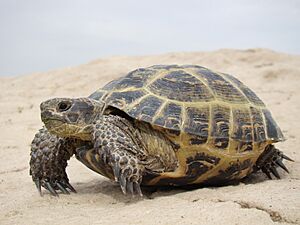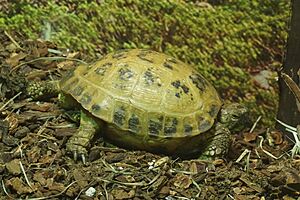Russian tortoise facts for kids
Quick facts for kids Russian tortoise |
|
|---|---|
 |
|
| A Russian tortoise in Kazakhstan | |
| Conservation status | |
| Scientific classification | |
| Genus: |
Testudo
|
| Species: |
horsfieldii
|
| Subspecies | |
|
|
The Russian tortoise (Testudo horsfieldii) is also known by many other names, like the Afghan tortoise or the Central Asian tortoise. It's also called the four-clawed tortoise because of its four toes. This tortoise is a threatened species of tortoise from the family Testudinidae.
You can find these tortoises only in Central Asia. Their home stretches from the Caspian Sea down through Iran, Pakistan, and Afghanistan, and east into Kazakhstan and China. Sadly, things people do in their natural homes are making them a threatened species.
Did you know that two Russian tortoises were the first Earth creatures to travel to and circle the Moon? This happened on the Zond 5 mission in September 1968!
Contents
What's in a Name?
The name horsfieldii and the common name "Horsfield's tortoise" honor an American naturalist named Thomas Horsfield. He was a scientist who studied nature.
How Scientists Group Them
Scientists group animals based on their features. The Russian tortoise is usually placed in the Testudo group. For a while, some scientists thought it should be in its own group called Agrionemys because it looked quite different.
However, in 2021, experts decided to put it back into the Testudo group. They now consider Agrionemys a special subgroup within Testudo. There are five different types, or subspecies, of Russian tortoise. These are:
- T. h. bogdanovi – found in southern Kyrgyzstan, Tajikistan, Uzbekistan, and Turkmenistan.
- T. h. horsfieldii – found in Afghanistan, Pakistan, and southern Central Asia.
- T. h. kazachstanica – found in Kazakhstan and Karakalpakstan.
- T. h. kuznetzovi – found in northern Turkmenistan and southern Uzbekistan.
- T. h. rustamovi – found in southwestern Turkmenistan.
About the Russian Tortoise
The Russian tortoise is a small tortoise. It usually grows to be about 13 to 25 centimeters (5 to 10 inches) long.
Size and Appearance
Female tortoises are a bit bigger than males. They grow to about 15 to 25 cm (6 to 10 inches) to make space for their eggs. Males are usually 13 to 20 cm (5 to 8 inches) long.
You can often tell males and females apart. Males usually have longer tails that they keep tucked to the side. They also have longer claws. Females have a short, thick tail and shorter claws. The male's vent (where waste comes out) is a slit shape, while the female's is shaped like an asterisk. Russian tortoises are special because they have four toes on each foot. Their shells can be reddish-brown or black, with yellow parts between the shell plates. Their bodies are usually straw-yellow and brown.
Reproduction
When a male Russian tortoise wants to mate, he bobs his head, circles the female, and gently bites her front legs. If she is ready, he will climb onto her back. During this time, he makes high-pitched squeaking sounds.
Hibernation
Russian tortoises often go into a deep sleep called hibernation. They can hibernate for about 8 weeks to 5 months each year if the weather is right. They can even spend up to 9 months of the year resting in a dormant state.
Where They Live
Russian tortoises love dry, open places. They prefer sandy areas where they can move around easily and dig. Even though they like dry places, they need some rain. Rain helps soften the soil so they can dig their burrows.
These burrows can be as deep as 2 meters (6.5 feet). The tortoises hide in these burrows during the hot middle of the day and at night. They come out to find food only at dawn or dusk when it's cooler. These tortoises can be quite social. They sometimes visit other burrows, and several might even sleep together in one burrow.
Russian Tortoises as Pets

Russian tortoises are popular pets. They are tough animals, but they do have special needs. If you keep a Russian tortoise indoors, it needs a very dry cage with good drainage. It's often better to keep them outdoors if you live in a suitable climate. Outdoor enclosures need less special equipment.
An indoor home for a tortoise should be large, about 8 feet long by 4 feet wide. This gives them plenty of space to move. Indoors, you need special lights to keep the right temperature and humidity. They also need UVB light, which is important for their health.
What They Eat
In captivity, Russian tortoises usually eat leafy greens like lamb's lettuce and plantains. In the wild, they eat grasses, twigs, flowers, and some fruits. It's important to give them a variety of foods to keep them healthy. Tortoises get most of their water from their food, but they still need fresh water available all the time. Young tortoises should be soaked in lukewarm water a couple of times a week. The water should not be deeper than their elbows. This helps them stay hydrated. Tortoises often go to the bathroom in water, which is a natural instinct to hide their scent. It also helps keep their home cleaner.
Russian tortoises can live for up to 50 years! They need to hibernate every year.
First Animals to Circle the Moon
In September 1968, two Russian tortoises made history. They flew to the Moon, circled it, and came back safely to Earth. This was part of the Soviet Zond 5 mission. Along with mealworms, plants, and other living things, they were the very first Earth creatures to travel to the Moon.


